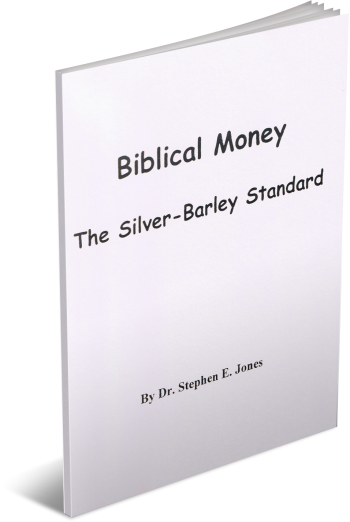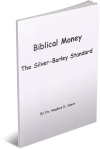Latest Posts
View the latest posts in an easy-to-read list format, with filtering options.

This is a 34-page primer that shows the difference between the monetary system of Babylon and that of the Kingdom.
Category - General

One of the laws was that they could not sell their land permanently. They could only sell its use until the Year of Jubilee, when it returned to them. And even if they sold it, they always had the right to redeem it before the Year of Jubilee—provided they had sufficient money to do so. The value of the land was measured according to the number of years remaining on the lease, multiplied by the land’s ability to produce barley (Lev. 27:16-18).
It is in this context that we are shown the Barley Standard as “a homer of barley seed at fifty shekels of silver” (Lev. 27:16). The value of land was its ability to produce barley, the staple food item for donkeys and average citizens. To calculate redemption prices, one needed a standard to convert land value to its common monetary equivalent.
Using this barley-silver equivalent, all other valuations could be measured and priced by that standard. But more importantly, there was a legal purpose for having a silver-barley standard. If a thief was caught and was unable to pay the required restitution to his victim, he was to be “sold for his theft” (Ex. 22:3). This meant that his property was first sold, and if that was insufficient to pay the debt, then he himself was sold as a slave (enforced servitude) until the debt was paid.
Since all Israelite families had a land inheritance, this was one of the thief’s assets to be sold. But how does one value land that is owned by God? It was not the land itself that was sold, but its future harvests. The value of the land, for legal purposes, was established according to its ability to produce barley year after year.
A homer of barley, in turn, was legally valued at fifty shekels of silver. So if the thief’s land was sold, he received compensation according to this legal standard of value, minus the value of the labor that the new “owner” expended in producing those harvests. (Obviously, no one would want to purchase land for precise amount that he would receive at the end of the harvests, for that would leave him with all the work and no profit to show for it at the other end.)
After the sale of the land, if any debt remained, the man would have to work off the debt in a court-ordered work program. The only difference between him and another hired servant was the fact that his servitude was mandatory until the debt was repaid in full—or until the year of Jubilee.
The only “sale” of land allowed was what we would call a LEASE, which could run for a maximum of 49 years. Every lease had to end no later than the day the priest blew the trumpet of the Jubilee—the tenth day of the seventh month, which was ten days into the fiftieth year of the calendar cycle (Lev. 25:8-10).
There is no prohibition against leasing land, if a family is rich enough to travel abroad for years, even decades. However, the VALUE of the land is predetermined, not according to its speculative value, but according to its ability to produce BARLEY. And a homer of barley was valued at 50 shekels of silver in those days.
We need not be legalistic about this standard in today’s world. With new methods of agriculture and mining, the standard may have to be altered in the real world today. The important factor is the principle that reveals the mind of God. The value of a “dollar” was set by our founders as the equivalent of one ounce of silver. At the same time, a buckskin on the Ohio River was valued at one dollar. Hence, a dollar was a “buck.” Though not valued in terms of barley, the principle was the same, and all men could trade “bucks” as if they were one ounce pieces of silver.
The effects of this legislation are enormous upon the national economy.
When God fixed the price of “a homer of barley seed at fifty shekels of silver,” it established both a silver standard and a barley standard, both derived from the land itself. The silver-barley standard was based upon the production from land, but not upon the land itself. Land belongs to God, and the divine law makes God’s created land inherently priceless. It can only be valued according to its productive ability. Hence, the biblical economy is not built upon a “land standard,” any more than on a gold standard.
Instead, it is built upon barley and silver. Barley is a product of farming the earth, while silver is a product of mining the earth. These two things represent all production from the land, and so they form the silver-barley standard. But it should be kept in mind that the true economic standard in Scripture is based upon ALL production and is not limited to barley and silver. Anything that has value is money or wealth, and this true money may be represented by currency.
The fact that 50 shekels of silver was the equivalent of a homer of barley was meant to establish the relationship between the amount of labor to mine and refine a shekel of silver and the labor needed to produce a homer of barley. It also presumed a non-inflationary economy.
The net effect of God's claim to ownership of all He created is that men cannot speculate on something they do not own. More than any other factor, this establishes a stable economy that is based upon production and labor—true wealth that man owns—rather than speculative wealth which leads to inflationary and deflationary cycles.
There is another connection between barley and silver that appears in the Hebrew calendar itself. In Exodus 23:15 says,
15 You shall observe the Feast of Unleavened Bread; for seven days you are to eat unleavened bread, as I commanded you, at the appointed time in the month Abib, for in it you came out of Egypt.
Abib was the first month on the Hebrew calendar, after God reset it in Exodus 12:2. The first month had been Tishri (September) previous to this, but under Moses Tishri became the seventh month.
Abib literally means “green ears.” It was a reference to barley. Exodus 9:31 says that during the plague of hail, “the barley was in the ear” (abib). The Hebrew calendar revolved around the cycles of the moon—hence, our word “month” is derived from “moon.” A year was twelve lunar cycles. But a lunar month was only 29 days long, and a lunar year was just 354 days. This was about 11 days short of a solar year.
And so, if Passover were held at the end of every twelve months, its celebration would regress eleven days each year. Soon Passover would be celebrated in winter. The problem was that Passover could not be celebrated without a sheaf of ripe barley to wave before the Lord on the first Sunday after Passover (Lev. 23:11).
To resolve this problem, and to keep Passover seasonal, they periodically added a leap month every two or three yeas. So the Hebrew year was often 13 months in length. At the end of each lunar year (12 moons, or months), they had to decide whether or not a leap month should be added to the year that was just completed. Their decision was based upon the ripening of the barley. If the barley was “eared out,” then it qualified to be waved before the Lord on the first Sunday after Passover. If the new moon was too early to see ripe barley, then they added a leap month to the previous year, postponing Passover for an extra month. This allowed barley time to ripen.
The point is that barley established the Calendar Standard. One might call it Barley Standard Time. If barley was so important as to establish the Hebrew calendar itself, it is not hard to see how barley was also a monetary standard. Barley was the staple diet of the common man and of donkeys.
As for the prophetic significance of barley, I have dealt with this in detail in my book, The Barley Overcomers. I showed there that barley speaks of the overcomers who are raised in the first resurrection (“harvest” from the ground). Even the English word “barley” is derived from bar, a Hebrew word for a Son, because it signifies Sonship.
The connection between barley and silver is likewise seen in the calendar, because from early antiquity gold was the sweat of the sun and silver was the tears of the moon. And so it was appropriate that the Hebrew-biblical economic, judicial, and lunar calculations would revolve around silver as well as barley.